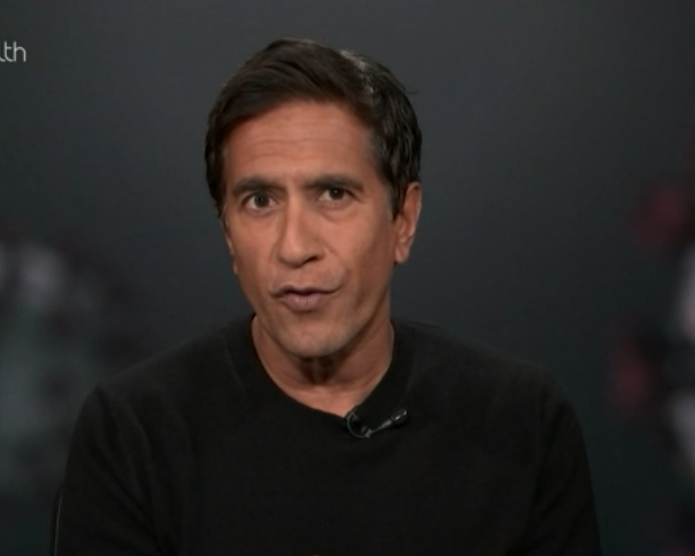
Eyck Freymann: How to Break China’s Minerals Chokehold
Why the allies need a multilateral commercial stockpile This essay is based on a Hoover History Lab working paper, co-authored with Joshua Stinson, William Norris,…
Thought Leader: Eyck Freymann

By Sanjay Gupta
Once vaccines were authorized for emergency use, the rules – as laid out in guidelines from the US Centers for Disease Control and Prevention – slowly started to change as more people got their shots.
This incremental loosening – too slow for some people – accelerated very quickly in mid-May, when the CDC surprised the public by announcing that fully vaccinated people no longer needed to wear masks outdoors or even indoors, except in a few circumstances.
While the news was certainly a cause for celebration, it also was a cause for confusion. Where we once had one universal, simple rule to follow – wear a mask – we each now have to perform a complicated calculus of risk assessment on a daily, if not hourly basis, as we navigate toward post-pandemic life.
Adding to the confusion is the patchwork of regulations that still exist in different states, cities and even public spaces like restaurants and stores. And, it’s impossible to tell who is vaccinated and who is not.
So, could we, should we remove our mask? If so, when? Where? And with whom?
When we try to solve problems or make decisions, we rely on “heuristics,” a fancy name for the rules of thumb, intuition and mental shortcuts that help with our judgment, according to Eve Wittenberg, a health decision scientist at the Harvard T.H. Chan School of Public Health.
Wittenberg said that we’re not used to doing the kind of math that’s required for the risk assessment involving the new mask guidance: We can’t rely on the “existing calculus in our heads” because the situation is not familiar. Additionally, we don’t know the probabilities of certain outcomes or the different factors that play into a situation like this one.
Author Maria Konnikova calls that “ambiguity” – the not knowing what the probability of certain outcomes are. And she said that it makes taking a risk, like whether to dine indoors, board a plane or attend that concert, even harder.
Konnikova, who has a Ph.D. in psychology, is also a professional poker player and a guest on this week’s episode of my podcast, “Chasing Life.” When I asked her about the connection, she told me that poker provides great insight into human behavior. She says poker and life are both full of probabilities and uncertainty, incomplete information and unknowns, and yet in both situations we are still forced to make a move. In poker, you have to also make a bet, which indicates your level of confidence. Are you willing to bet $10 that you don’t need to wear a mask? How about $100? Or $1,000? Betting on your decision forces you to evaluate risk more thoroughly.
“[But] with Covid, there’s actually an element that doesn’t exist in poker, which is even more taxing for the human brain, and that’s the element of ambiguity,” she explained to me.
Konnikova said we’re still in an environment of very high ambiguity. “[It] makes it very difficult for the human brain to kind of take it all and make decisions and stay rational, as opposed to being emotional,” she said, adding that as we learn more, that ambiguity decreases.
She said in this confusing time, it’s very important to seek out trusted sources of information and to be guided only by the data; you also have to put aside your emotions and be aware of your own biases.
But the most crucial tip for decision-making in poker and life is to update your decisions based on the incoming information.
“All of a sudden the information changes and your decision needs to be updated, potentially. Maybe it stays the same, but you have to constantly get used to this evaluation process,” she said. “You are not failing, you weren’t wrong, you are updating.”
When trying to assess your risk, remember that the CDC is talking about vaccinated people going maskless, not unvaccinated people. Covid-19 cases – and especially hospitalizations and deaths – are occurring mostly among this ever-shrinking unvaccinated group according to an analysis by the Washington Post. For the most part, unvaccinated people are primarily a risk to other unvaccinated people. They aren’t much of a risk to the vaccinated and the vaccinated aren’t much of a risk to them.
That is why Dr. Jay Varkey, an infectious disease expert and associate professor at Emory University School of Medicine, can’t stress the importance of vaccines enough.
“Number one: get vaccinated. Number two: get your family and those closest to you vaccinated,” he said. “If you’re vaccinated, if those closest to you, especially those you share a household with, are vaccinated, it makes all these activities easier.”
So how safe is being unmasked? Well, it’s not 100% safe: for people who are vaccinated, there can be what’s termed “breakthrough infections,” which basically means, a person can get infected even after getting vaccinated. But they’re rare.
There are two key points to remember: One is that you (the vaccinated person) are very unlikely to get really sick, even if you do have the rare breakthrough infection. The CDC reports that as of June 1, out of the 135 million Americans who are fully vaccinated, 2,274 either were hospitalized or died due to Covid-19. And the second point – and this is important for people who live with a child under 12 or someone who for health-related reasons can’t mount an immune response from a vaccine – even if you do get infected, the science is beginning to show that you’re very unlikely to then be contagious enough to spread the virus to somebody else in your family or community.
But there is still, as Konnikova says, ambiguity— we don’t know for sure that a vaccinated person can’t ever get silently infected and then infect someone else, even if it is very rare
It’s that little sliver of ambiguity that keeps Erin Bromage, associate professor of biology at the University of Massachusetts Dartmouth, up at night. Bromage, who also consults with organizations and businesses to find ways to lower the risk of infection in workplaces, said since the CDC changed the mask guidance, he’s received “non-stop” calls from worried clients wondering how to proceed.
“The big thing that we know is… people that are vaccinated are not ending up in ICU and are not dying … They’re [the vaccines] amazing in that respect,” he said.
But he wonders about what happens to the chain of transmission with a vaccinated person. “I think that the hole for me as a scientist is, even if I get infected … is the chain of transmission stopping with me, or if I get infected can I be part of that chain? And that’s the big part that I am having a hard time getting my head around,” he said.
This question as it relates to masking, he said, is particularly important when the distance is relatively close and the duration is long. “So think of a call center – eight-hour day shift, someone that is six to eight feet away from you and talking all day. Is that person a risk to an unvaccinated person that’s there? And that’s what’s not settled for me,” he said. He is comforted by the data he has seen so far showing that there is “a million-fold difference in virus in your nose” if you are vaccinated and you get infected versus if you are not.
“So, the indication would be that they would have a harder time transmitting and they almost certainly would have a harder time transmitting to a vaccinated person,” he said.
Bromage said that for individuals who don’t work in call center-like conditions – most of us – it’s really about assessing the situation that you’re in and taking steps to mitigate the risk.
“The best vaccine reduces your risk 10-fold of being infected,” he said. “A good quality [N95, KN95 or KF94] mask reduces your risk about 20-fold … Physical distancing and avoiding high risk situations – restaurants, gyms, things like that – also have a multiplicative factor in regards to risk reduction.” He said the Swiss cheese model of adding different layers of protection can lower your risk of being infected “30-, 40-, 50-fold.”
Are you risk-tolerant or risk-averse? Some people believe certain individuals don’t want to take chances like unmasking in public because their nature makes them more cautious. But James Hammitt, a professor of economics and decision sciences and the director of the Harvard Center for Risk Analysis, sees it a little differently. “My sense is, it’s more that people differ a lot in which things they worry about,” he said.
“Knowing that the risk [of a particular activity] is X doesn’t tell you what you should do…. The question is: Is that worth it? And that’s more a matter of preference: what do you gain by exposing yourself to the higher risk? It might be a very valuable activity to you; in that case it might be worth taking the risk… There’s no objectively right answer to that.”
He said a simple way to choose is to make a direct comparison: “Is the value of the concert [for example] greater than the harm from this risk to me?”
Hammitt echoes what Wittenberg and Konnikova said, we’re never going to have enough information to estimate the risk of anything perfectly. “The world is so complicated; everything is full of risk. We cannot be experts on most of what we do. It’s just not possible,” he said.
That’s why he thinks it makes sense to have experts first provide information. Then, we as individuals should evaluate how trustworthy we consider it and how relevant it is to our own situation. “Somehow we combine information from many, many sources and use that to assess how big our risk is and how acceptable it is, and how important it is to do things to reduce it,” he explained.
One large group of people who may choose to be more cautious are parents of kids under 12, a group who can’t yet get vaccinated. And I know for a fact – because I receive your letters – that many are confused about when it’s OK to skip the mask. It’s a question that is pressing, especially now that summer is rolling around. Let’s face it: Masks are hard to wear in the heat, even for grown-ups.
The good news is that children don’t get infected as easily and don’t get as sick as often as adults do. But the bad news is some do; nearly 4 million children have tested positive since the start of the pandemic.
Even though it’s tempting to set aside the mask, many medical and public health experts are erring on the side of caution. The American Academy of Pediatrics recommends that children age 2 or older who are not fully vaccinated still wear a mask when out in public – including at camp, when playing with friends, and while playing outdoor sports with close contact and indoor sports. And while the CDC dropped its mask requirement for fully vaccinated campers and counselors, it didn’t for those who are too young to get their shot.
Varkey agrees that continued mask-wearing for the under-12 set is prudent and calls for a little bit more patience.
“What I would say, especially for those with children … who don’t yet qualify for any of the currently available vaccines is to sit tight,” said Varkey. “I think it’s the safe, conservative thing to do for kids, for their fellow students, for their teachers, and then also for the families that they go home to.”
Another group that’s also probably more risk-averse: people who don’t mount a strong immune response to the vaccine either because they are immunocompromised or take certain medications that suppress their immune system, like drugs for rheumatoid arthritis and inflammatory bowel disease. These medically vulnerable people – and those who live with them – will likely be more cautious about removing their masks, too.
National Institutes of Health Director Dr. Francis Collins estimates that 5% of the population, or about 16.7 million Americans – fall into that category.
And that’s why getting vaccinated, if you’re able to, is so important – because it protects children and the medically fragile among us. That’s the essence of herd immunity.
“Even if you think you don’t need to, think about this as a donation of your own goodwill to those who are more vulnerable,” Collins said on CNN last week. “The only protection those folks are going to have – and they’re 5% of us – is because the rest of us provide this blanket of immunity.”
And that’s also why it’s important to remember it’s OK to keep wearing a mask, if that’s what you feel your situation calls for. In fact, I carry a mask in my pocket all the time and if somebody is very concerned, out of respect, I’ll put that mask on. And maybe also if I’m on an elevator or someplace similar. Shaming someone who wants to wear a mask serves no advantage. People are nervous and people are cautious; it’s been a traumatic year for us all, and some of us might take longer than others to get to where they feel safe enough to go mask-free.
CNN Health’s Andrea Kane contributed to this report.
Eyck Freymann: How to Break China’s Minerals Chokehold
Why the allies need a multilateral commercial stockpile This essay is based on a Hoover History Lab working paper, co-authored with Joshua Stinson, William Norris,…
Thought Leader: Eyck Freymann
Chris Miller: Robotics Manufacturing: The Rise of Japan
“To the Americans, a robot is a computer attached to a mechanism. To Japanese, a robot is a mechanism attached to a computer.” The future…
Thought Leader: Chris Miller
Dr. Sanjay Gupta: A New Understanding of Parkinson’s Disease
Parkinson’s disease, a progressive movement disorder whose hallmark is damage to the dopamine-producing neurons in the brain, afflicts almost 12 million people worldwide. And the…
Thought Leader: Sanjay Gupta

